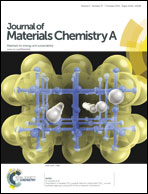Branched CNT@SnO2 nanorods@carbon hierarchical heterostructures for lithium ion batteries with high reversibility and rate capability†
Abstract
A novel hierarchical heterostructure consisting of carbon-coated SnO2 mesocrystalline nanorods radially aligned on carbon nanotubes (CNTs) was designed and fabricated by a two-step growth process. SnO2 nanorods were first grown directly on CNTs through a facile solvothermal reaction, which were subsequently coated with a thin layer of carbon to form a branched CNT@SnO2@carbon sandwich-type heterostructure. When used as an anode material in lithium ion batteries, the branched CNT@SnO2@C heterostructures exhibited highly reversible lithium storage behavior and excellent rate capability. The reversible capacity of the CNT@SnO2@C heterostructure reached 984 mA h g−1 at a current density of 720 mA g−1, and retained 590 mA h g−1 at 3.6 A g−1 and 420 mA h g−1 at 7.2 A g−1. This superior performance might be ascribed to the improved mechanical capability and high loading content of SnO2 of the branched architecture, the good electrical conductivity of the CNT backbones and the carbon layer, and the high electrochemical reactivity of the 1D mesocrystalline SnO2 nanorods.


 Please wait while we load your content...
Please wait while we load your content...